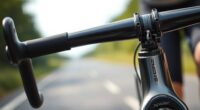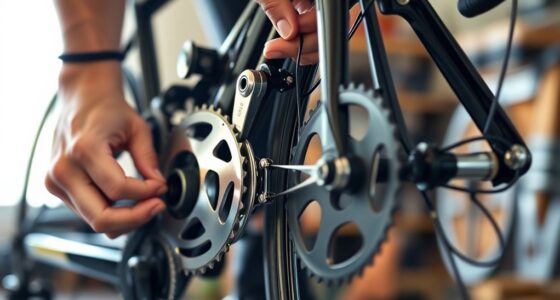To pack for a bicycle camping trip, start by evaluating your gear needs based on weather and activities, choosing lightweight, weatherproof containers for easy access. Organize essential items like clothing, cooking gear, and tools into separate, clearly labeled bags, securing heavier items low and centered on your bike for balance. Balance weight evenly and ensure quick-access essentials are within reach. For more expert tips on efficient packing, continue exploring to prepare your adventure thoroughly.
Key Takeaways
- Use weatherproof, labeled containers to organize clothing, gear, and food for quick access and protection against elements.
- Pack lightweight, moisture-wicking layers for daytime riding and insulated clothing for evenings to suit weather conditions.
- Secure heavier items low and centered on the bike for better balance; keep tools and essentials easily accessible.
- Distribute weight evenly across racks and bags to maintain stability and prevent fatigue during the ride.
- Double-check all gear, including safety equipment and weather-appropriate items, before setting out for a smooth trip.
Assessing Your Gear Needs and Essentials
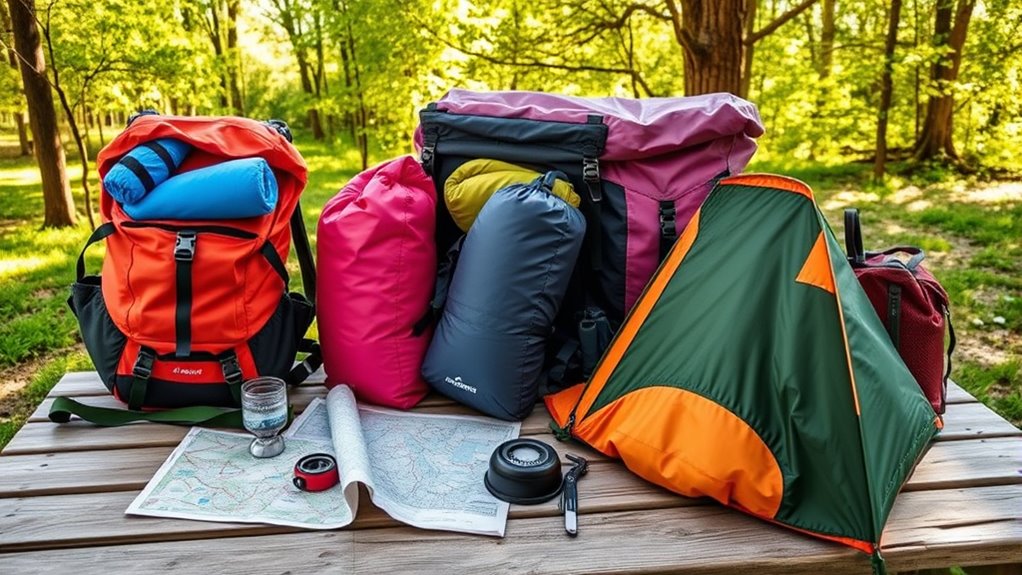
Before packing for your bicycle camping trip, it’s vital to evaluate what gear you’ll actually need. Start by considering your clothing options based on the weather forecast and planned activities. Pack moisture-wicking layers for daytime riding and warm, insulated clothing for evenings. Think about how many changes of clothes you’ll need and whether you’ll want versatile pieces for different conditions. Remember to include dog quotes for reflection and humor if you’re traveling with a canine companion to keep spirits high during downtime. Meal planning is equally important; determine how many meals you’ll prepare and pack lightweight, non-perishable foods accordingly. Include utensils, a stove, and fuel if necessary. Keep your gear minimal but sufficient to stay comfortable and safe. Additionally, consider incorporating Halloween-themed accessories to add some festive spirit to your trip, especially if you plan to celebrate during your adventure. Planning for effective organization can help ensure easy access to your essentials and prevent overpacking. Good organization not only saves space but also enhances your gear accessibility, making your trip more enjoyable. Proper organization reduces gear clutter and helps maintain balance on your bicycle, which is crucial for safety.
Choosing the Right Packing Equipment and Containers
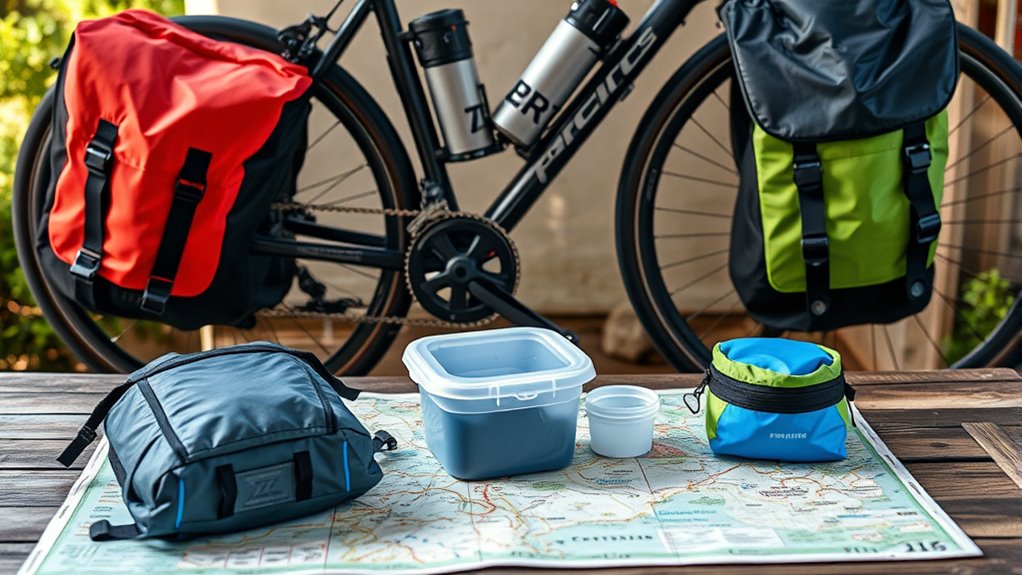
Selecting the appropriate packing equipment and containers is essential to keeping your gear organized, protected, and easy to access during your bicycle camping trip. Opt for weatherproof storage options to shield your belongings from rain, mud, and other elements.
Durable, lightweight containers help reduce overall bike weight, making pedaling easier and conserving energy. Consider using waterproof duffel bags, dry bags, or plastic bins with secure closures to prevent moisture damage.
Clear, labeled containers allow quick identification of items without rummaging through your gear. Small, compact containers are perfect for toiletries, snacks, or tools, while larger ones hold clothing and camping gear. Incorporating weather-resistant storage and specialized containers like eye patches can also help keep delicate or small items protected and organized. Additionally, selecting containers made from lightweight materials can further optimize your packing efficiency and ease of transport during your trip.
Organizing and Strategically Packing Your Bike

To maximize stability and ease of access, organizing and strategically packing your bike is essential. Start by grouping items based on importance and frequency of use, which simplifies route planning and bike maintenance checks. Secure heavier gear low and centered to maintain balance. Use the following table to plan your packing:
| Item Category | Placement Strategy |
|---|---|
| Tools & Spare Parts | Attach near the frame for quick access |
| Lightweight Items | Place in handlebar or top tube bags |
| Heavy Gear | Load into rear panniers or racks |
Additionally, considering weight distribution during packing can greatly improve your riding experience and safety. Proper packing techniques can help prevent damage and ensure comfort during your trip, especially when managing delicate or fragile items. For added stability, it’s also beneficial to check your bike’s center of gravity before heading out.
Balancing Weight and Accessibility for Easy Riding

Balancing weight and accessibility is essential for maintaining control and ensuring a smooth ride during your camping trip. Use lightweight gear whenever possible to reduce bike strain and improve maneuverability. Distribute this gear evenly across your bike to keep the center of gravity low and stable. Proper placement of safety equipment, such as a fire extinguisher, can enhance your preparedness in case of emergencies. Prioritize packing items in quick access pockets, so essentials like snacks, maps, and tools are within easy reach without stopping. Avoid overloading your bike’s rear or front racks, which can cause imbalance or make pedaling difficult. Keep heavier items close to the frame for better stability, as understanding of financial management is key to planning your gear and supplies effectively. Additionally, being aware of anime movies can inspire creative packing ideas and entertainment options for your trip. Incorporating sound healing science principles, such as using calming sounds during rest stops, can also improve your overall experience. Planning your gear with compact and efficient packing techniques can further enhance your riding experience and comfort.
Final Checks and Tips for a Smooth Packing Process
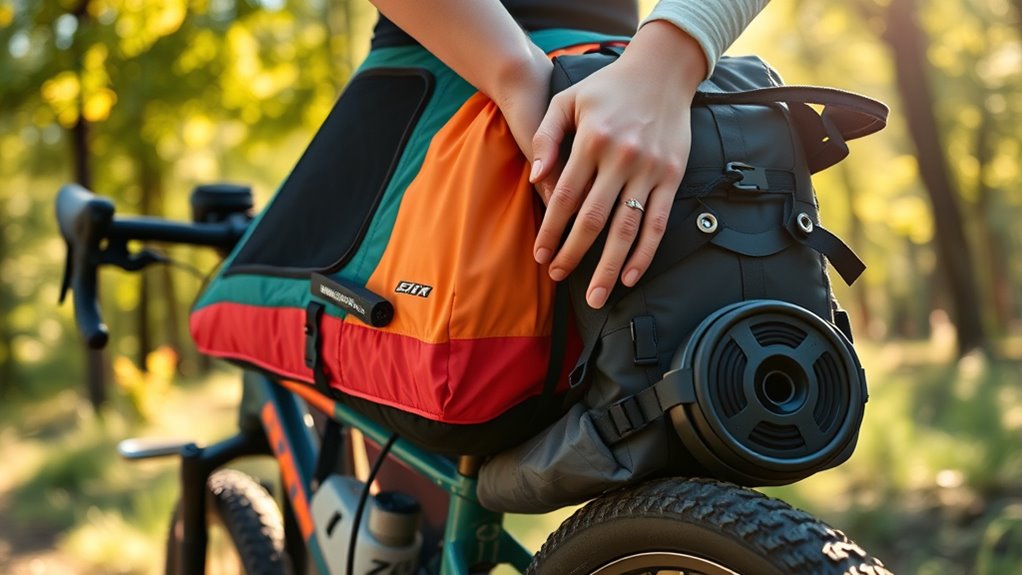
Before you hit the road, taking a few final checks can prevent surprises and guarantee your packing is complete. Review your packing checklist to assure you haven’t missed essentials like tools, clothing, and food. Consider weather considerations—check the forecast and verify you have appropriate gear, such as rain gear or sun protection. Remember to examine your camping gear reviews to confirm that your equipment is in good condition and suitable for your trip. To streamline your process, focus on these key steps:
- Double-check all items are securely packed and easily accessible.
- Ensure your bike’s essential tools and spare parts are included, especially bike repair kits to handle any mechanical issues on the trail.
- Confirm you’ve packed weather-appropriate clothing and gear for any forecasted changes. Incorporating proper packing techniques can help maximize space and protect your gear during the journey.
- Assess your beach destination to prepare for specific environmental conditions you might encounter.
- Be aware of symptoms of breast cancer that could affect your health during the trip, especially if traveling alone or for an extended period.
Doing these final checks helps you avoid last-minute scrambling and sets you up for a smooth, enjoyable camping trip.
Frequently Asked Questions
How Do I Pack for Different Weather Conditions?
When facing different weather conditions, you need to plan carefully. Consider weather gear considerations like waterproof jackets, thermal layers, and moisture-wicking clothing.
Use clothing layering techniques—start with a moisture-wicking base, add insulating layers, and finish with a waterproof outer shell. This way, you stay comfortable and dry, no matter the weather.
Pack versatile pieces that can be combined or worn separately, so you’re prepared for sudden changes.
What Should I Do if My Gear Gets Wet?
Imagine your gear soaked, the dampness seeping into your journey’s core. First, you strip off any wet clothing and switch into dry clothing to stay warm.
Next, you focus on moisture protection—use a rain cover or plastic bag to shield your gear from further water damage. Keep your essentials dry, and consider drying items at night or with a portable dry bag, so you’re prepared for what’s next.
How Can I Prevent Gear From Shifting During Rides?
To prevent gear from shifting during rides, you should use gear anchors to secure your items firmly.
Proper weight distribution is key—place heavier gear low and centered to keep your bike balanced.
Additionally, tighten straps and bungee cords, ensuring nothing moves or rattles.
Check your gear regularly during rides and readjust if needed.
Staying mindful of these tips helps maintain stability and control on your cycling adventure.
What Are Some Space-Saving Packing Tips?
When it comes to space-saving packing, you should focus on a minimalist approach and prioritize compact packing.
Use multi-purpose items to reduce the number of things you bring.
Roll your clothes tightly to save space and avoid bulky bags.
Opt for lightweight, compressible gear, and pack essentials only.
This way, you maximize your limited space, stay organized, and guarantee a smoother ride without unnecessary weight or clutter.
How Do I Handle Emergency Repairs on the Road?
When handling emergency repairs on the road, you need to stay calm and prepared. Carry puncture kit essentials like tire levers, patches, and a mini pump.
For bike chain repair, bring a chain tool and master link or quick links. Practice these repairs beforehand so you’re confident.
With the right tools and knowledge, you can quickly fix flats or chain issues, ensuring your trip continues smoothly.
Conclusion
Proper packing can make or break your bike camping trip. Did you know that over 60% of cyclists say that well-organized gear enhances their riding experience? By evaluating your needs, choosing the right containers, and balancing weight, you set yourself up for success. Remember, a little planning now ensures smooth riding and enjoyable adventures. Pack smart, stay safe, and embrace the open road—your next great journey awaits just a well-packed bike away.

